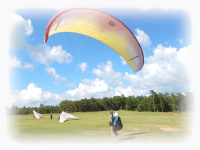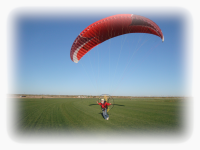General info, tips, suggestions, and options for paramotors
Most paramotors share a common design. If you cannot find the info you need below, check the specific sections of your particular engine.
Before putting any paramotor in service, new or used, CHECK THE TORQUE of the head nuts!
Air box – the air box usually has an internal air filter. It must *NOT* be saturated with oil. It is unnecessary and can restrict air flow into the engine. Periodically wash the filter in hot soapy water.
Air filter – see "Air box" above
Altitude – Engine output will drop about 100 RPM for every 1,000' of altitude above sea level. Propeller condition and type will also influence power output dramatically.
Assembly of a paramotor – here are the basics
Bearing condition – What condition are the bearings in my engine? Which one is the most likely to fail first?
Bearing lubrication – from NTN of Japan. This tech-tip is about roller bearings, in particular, but has excellent info on lubricants and how they work.
Bearing replacement and crankcase disassembly/assembly – Here is how to replace the main crankshaft bearings and seals
Belt adjustment – How to adjust the redrive belt on any engine
Breaking in a new engine – a new engine generates more friction than usual. It MUST be broken in carefully so it will last.
Carburetors – WG & WB Husqvarna 503282001 Polini carburetor
Carburetor Dimensions – by Gerry Farell – This information compares the dimensions of the various Walbro carburetors and is helpful if you are considering alternatives to the WG.
Carburetor preheat system – see "Cold weather operations" below
Carburetor performance tuning – see "Performance tuning" below
Choke – What does it do? Why have it?
CHT – see "Cylinder head temperature gauge" below
Clunk – see "Fuel filter" below
Clutch bearing replacement – It is done in the same manner as for the main bearings (see Bearing replacement... above). Steel does not expand as much as aluminum so a press must be used to install them. They will not just "clink" into place.
Compression check – One of the best ways to quickly check the overall health of an engine.
Connecting rod – see "Rebuilding a paramotor" below for info on this part including when it should be replaced (which must include the entire crankshaft).
Crankcase pressure test – The only way to be sure the main seals and various gaskets are not leaking.
Crankcase assembly/disassembly – see "Bearing replacement and crankcase assembly/disassembly" above.
Crankshaft replacement – see "Rebuilding a paramotor" below. The paramotor must be completely disassembled.
Cruise control – Not a good idea and here is why
Cylinder head temperature gauge – Not having a CHT is like driving a car without any gauges or warning lights. Most of the time you don't need them....
De-carbonizing a two stroke engine – Alex Varv shows how to do it without removing the cylinder. However, I do not recommend using any sealant between the cylinder and cylinder head. I have never had a head leak when the "O" ring is new and installed properly. The exhaust port should also be cleaned at the same time.
Decompression port check – Here is an easy, simple way to check whether the port is clogged or not.
Decompression port cleaning – It must be clear. Failure to keep it free of combustion deposits will greatly shorten the life of the starter.
Drips – Two stroke engine carburetors drip/leak fuel by design. It cannot be helped.
EFI ignition systems – why not install one?
Electrical troubleshooting – see "Ignition troubleshooting" below
Engine performance issues – see "Performance tuning" below
Engine stall – see "Stall" below
Emergency engine kill system – see "Kill system, alternate" below
Exhaust port cleaning – after many hours the inside of the exhaust port and the manifold can have substantial deposits of carbon and/or lead phosphate/monoxide.
External pulse port installation – needed on some engines for installation of the FSM
Flywheel removal and installation
Frozen screws – how to remove them
Frame cracks – see "Metal fatigue" below
Frame information for the Miniplane – see "Miniplane frame information" below
Fuel & oil specifications – Pilots must use the correct gasoline and oil for long engine life
Fuel filter – What kind/type to use? If you choose poorly, the engine will also run poorly, if at all. Removal and installation tips. The fuel system MUST be purged of old fuel and air when changing out the fuel filter!
Fuel line installation – Silicone grease may be used to aid installation and lower the chance of splitting less expensive line. Modest use of a heat gun also helps lower the stress on the line. Some pilots insert the end of a pair of needle nosed pliers to increase the diameter of the line, much like using a fid. BE ABSOLUTELY CERTAIN THAT THE FUEL LINE AT THE CARBURETOR INLET IS NOT LEAKING! If there is no clamp at the inlet, use a 3/32" (2.5mm) nylon zip tie double wrapped around the tubing. A leaking fuel line at the carburetor inlet will allow air to enter and may cause a lean condition when the engine is at or near full throttle, possibly burning it up.
Fuel line types – Most paramotors: 3/16" (4mm) ID line throughout. Some of the smaller engines may use 1/8" (3mm) ID from the inline fuel filter to the carburetor. Tygon® LP1100 and Excelon Fuel & Lubricant line are premium quality. They are expensive but will last for years and will not split. Other fuel line offered on Amazon and eBay is not good quality. Miniplane-USA sells quality OEM fuel line by the foot. You get what you pay for per a line's chemical stability and resistance. Do NOT use ordinary vinyl tubing, rubber hose, or the black fuel line from China. They will become stiff quickly and stress the connections on the tank and engine. Auto parts stores do not have the right type. Pilots outside the U.S. may not have Tygon® or Excelon line available and will have to do some research to find lines that are gasoline and ethanol resistant.
Fuel mixed? – Is there oil in the gasoline?
Fuel system equipment – What do you need to safely fill and drain your tank? Oil mix bottle? Storage tank sizes?
Fuel system leaks – (see also "Leaks of the engine" below)
Fuel system modification – the FSM forever fixes fuel starvation and most performance issues (in the final testing phase)
Fuel system test – A thorough test of the fuel system. This is the quick version of the test.
Fuel tank leaks – How to fix most factory defects.
Harness adjustment – This is for the Miniplane Top 80 but works for most other harnesses.
Harness strap repair – Thin, tall pilots routinely experience buckle breakage on some harness models. Here is a simple fix for the problem.
High altitude use – Pilots can improve performance at high altitudes and/or cold conditions by modifying the WG and WB carburetors.
Idle stalling – see "Stall" below
Ignition timing – How to accurately set the timing on most paramotors
Ignition timing check – This method will give the precise timing value that 100% mechanical methods are unable to do.
Kill system, alternate – The Italians have demonstrated poor quality control over the years, including faulty cabling and connectors in the kill switch system installed on paramotors. This could be exceedingly dangerous with any engine, especially with ones over 130cc.
Leaks, carburetor – see "Drips" above
Leaks of the engine, exhaust, or redrive (also, see "Fuel system leaks" above)
Leaks of the reed valve – see "Reed valve" below
Metal fatigue – Pilots who put 100's of hours on any paramotor must keep an eye out for this hazardous and hard to see problem.
Midrange roughness & "four cycling" – see "Performance tuning" below
Miniplane frame information – options, sizes, side stick lengths, etc.
Mounts, engine – Mounts must be checked often. If you replace them with the Viking mounts, do not make the mistake this pilot made.
Muffler clogging – paramotors all have the same type of muffler (straight tube, glass packed). They also share the same problem of the insides coming loose which can restrict the exhaust stream through the engine. Engines with clogged mufflers have trouble idling.
Muffler repair – typically, the perforated SS tube inside of the muffler may break apart because of vibration and come loose, blocking the flow of exhaust gases.
Muffler springs – Use paraglider line to stretch the springs for replacement/removal. Do NOT use pliers to stretch the springs because this will nick the tempered surface of the spring and weaken it. Here is a video on how to properly do it
Overhaul – see "Rebuilding a paramotor" below
Overheating – This will destroy an engine. What causes it? How is it prevented?
Performance issues – Does your engine run poorly, roughly, or with a lot of engine vibration? This page can help.
Performance tuning – Most paramotors run poorly in the midrange (where it runs most of the time). The Walbro carburetor can be safely modified.
Piston failure – This page from Madsen's (a chainsaw dealer) gives many maintenance and repair tips on 2 stroke engines including the piston. Paramotors are more like chainsaws and motorcycle racing engines than any other. Paramotors use carburetors from obsolete chainsaw.
Piston replacement – Motocross Parts in the U.K. published these helpful notes on sizing a replacement piston.
Piston ring – How to tell if the ring needs replacement
Preheat system of air entering the carburetor
Priming a paramotor – see "Starting a paramotor" below
Propeller drag – how to stop the propeller from being a windmill and causing drag when the engine is stopped or at idle.
Propeller hub info, removal, & installation – this page is particularly about the Top 80 but has important information relevant to all hubs, especially vibration sources.
Propeller info – General information including how to correctly balance, attach, and repair it.
Purging the system of fuel – It must be done if a paramotor is to be stored for more than a few weeks, especially if you are using ethanol fuels.
Rebuilding a paramotor – disassembly and assembly of the major parts of a paramotor
Redrive gear noise – it can be safely ignored. The noise will be more pronounced when the prop is rotated in one direction vs. the other.
Redrive leaks – see "Leaks of the engine, exhaust, and redrive" above
Redrive repair – see the appropriate section of "Rebuilding a paramotor" above
Reed valves – Info on how to check them and replace them, if necessary
Removing frozen screws – see "Frozen screws" above
RTV (room temperature vulcanizing) cement – e.g. Permatex Blue or Ultra Grey. Used to seal case halves, some gaskets, and surfaces. Apply with a clean finger. Forget the spout that comes with the tube. It is useless. Use Ultra Grey for sealing surfaces that may become hot, like the exhaust flange gasket. More sealant is not better. It is not as simple as most think.
Safety wire – It is used copiously on all certified aircraft engines. Here are some tips on how to use it (from BobMartinCo.com)
Sidestick mount protection (Miniplane only) – The sidebars and sidestick mounts will grind away on each other. Here is a fix.
Smoke systems – Pilots must be extremely cautious when installing smoke systems on any 2 stroke engine with a tuned exhaust and here is why.
Spark plug NGK info – Meaning of the NGK part number
Spark plug cap replacement – It is not that simple if you want it to last and work well.
Spark plug installation and information – do not waste time tinkering with the carburetor unless the spark plug is gapped and installed correctly.
Spark plug reading – How to do it. A cylinder head temperature gauge (CHT) is essential and will confirm what the observed condition of the spark plug. Also see "Electrical troubleshooting" above.
Speed system pulleys – pilots are plagued with the poor quality, high friction Viadana pulleys from Miniplane. What's a good replacement?
Spring removal and installation – see "Muffler springs" above
Stall – Going to full throttle, the engine stalls. Or, the pilot bends over and the engine stalls. What are the causes?
Starting a paramotor – with this technique, your engine will start with the first pull every time.
Storage – If you are storing your paramotor for more than a few weeks, PURGE THE FUEL SYSTEM!
Stuttering in the midrange – see "Performance tuning" above
Tachometer – Is your engine due for routine maintenance? Has power output changed? You won't know without a tachometer/hour meter.
TROUBLESHOOTING a paramotor
Threadlock – An important item in a pilot's toolbox
Throttle cable – Cleaning, important modifications, and cruise control info. For kill switch issues, see "kill switch problems" above.
Throttle placement in the hand while launching a paramotor
Timing – how to both check and set the timing of a paramotor
Tools – Paramotor essential tool kit The list here is from Harbor Freight of the U.S.A.
Torque Values – This is the Top 80 specification page which has a thorough torque section.Tune up – Here's how to tune up the Walbro carburetor
Vapor lock – it is the most common fuel problem in paramotors due to the near universal location of the fuel tank far below the carburetor
Vibration – see "Propeller hub info, removal, & installation" above
Warming up – When the cylinder head temperature reaches 70ºC (or what is specified in the owner's manual), the fuel/air mixture is 100% vaporized so the engine will not be fuel starved and potentially overheat. Various moving parts of the engine must also be at the correct temperature to reduce wear and seal properly.
Vapor lock – it is the most common fuel problem in paramotors due to the near universal location of the fuel tank far below the carburetor
![]()




